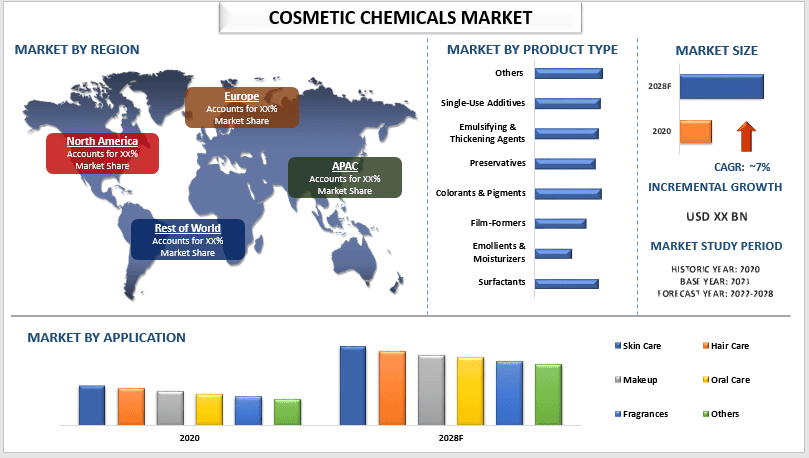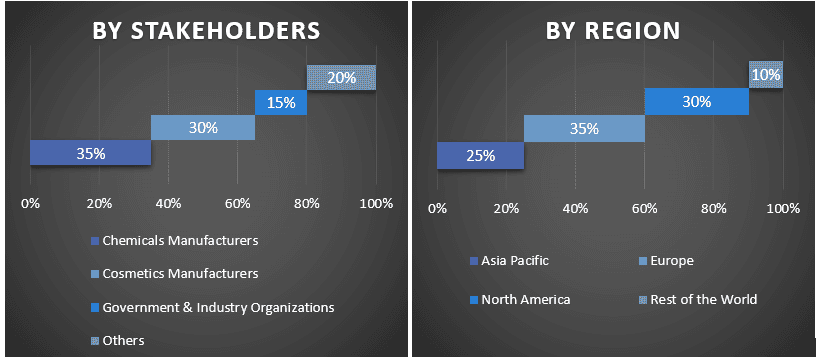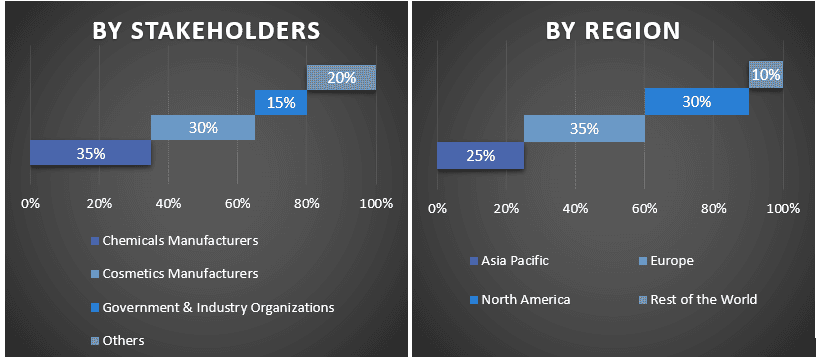Emphasis on Product Type (Surfactants, Emollients & Moisturizers, Film-Formers, Colorants & Pigments, Preservatives, Emulsifying & Thickening Agents, Single-Use Additives, and Others); Application (Skin Care, Hair Care, Makeup, Oral Care, Fragrances, and Others); Region/Country

The Cosmetic Chemicals market is expected to register a CAGR of around 7% over the forecast period (2022-2028). Increasing beauty consciousness and health awareness are prime factors boosting the market for cosmetics products. In addition, demand for organic grade cosmetic chemicals is being driven by the growing adoption and penetration of natural and organics cosmetic products along with the consumer readiness to pay more for premium goods.
The industry is categorized by continuous research and development activities related to product innovation. Market players are focused on obtaining sustainable formulations made from natural ingredients that are free of artificial additives. For instance, in June 2022, BASF SE launched Verdessence RiceTouch. It is perfectly suited for various fields of natural and organic cosmetics including face and body care, hair care and body cleansing, color cosmetics and sun care while reducing greasiness of formulations.
Some of the major players operating in the market include Cargill Inc., BASF SE, Stepan Company, Evonik Industries AG, Ashland Inc., Croda International Plc, Bayer AG, Clariant International Limited, Dow Inc., and Solvay SA.
During the COVID-19 pandemic, there was a negative impact on the cosmetic chemicals market due to the implementation of lockdowns and social distancing measures in several countries across the world. As a result, people stopped moving outdoors except in the cases of necessity, which led to a decline in the customer spending on non-essential products, such as cosmetics, thus leading to a reduction in the demand for cosmetic chemicals.
Insights Presented in the Report
“Amongst product type, emollients & moisturizers to hold prominent share during the forecast period”
Based on product type, the market is segmented into surfactants, emollients & moisturizers, film-formers, colorants & pigments, preservatives, emulsifying & thickening agents, single-use additives, and others. In 2020, emollients & moisturizers held significant market share. This is mainly due to rising awareness about personal grooming and rapidly changing lifestyles are further enhancing the emollients market worldwide. Basically, these are non-cosmetic moisturizers that are readily available in the form of gels, ointments, lotions, and creams. Furthermore, emollients are often used to help manage dry, itchy, or scaly skin conditions such as eczema, psoriasis, and ichthyosis. Thus, the increasing prevalence of skin conditions like eczema and psoriasis is resulting in the high demand for the related treatments and cosmetics. According to the National Psoriasis Foundation, 125 million people across the world were reported to have psoriasis, as of 2020, which is significantly higher compared to the disease prevalence reported in the year 2016, which was approximately 100 million.
“Amongst application, in 2020, skin care segment accounted for majority share in the market”
Based on the application, the market is categorized into skin care, hair care, makeup, oral care, fragrances, and others. In 2020, skin care segment accounted for majority share in the market. Escalating demand for face creams, sunscreens, and body lotions across the globe is expected to have a positive impact on the market growth over the forecast period. In addition, growing consumer awareness of natural cosmetics and the desire of cosmetics companies to replace synthetic ingredients with natural variants are the main drivers of this growth. Thus, major Cosmetic Chemicals manufacturer are launching new and advanced organic raw materials for skin care products.
“APAC is expected to witness highest growth in the market”
During the forecast period, APAC is expected to witness highest growth owing to the rising adoption and use of luxury and premium personal care cosmetics. In addition, major mass cosmetics manufacturers like The Proctor & Gamble Co., L’Oréal S.A., Unilever plc, and Natura & Co, among others are rapidly increasing market penetration in emerging economies of the region. Thus, creating demand for Cosmetic Chemicals. Furthermore, Cosmetic Chemicals market in the region is further expected to witness growth due to the demand for organic and personal care products. Beauty and cosmetic products that are free from chemicals and transparent about the content have been preferred by consumers, which is likely to drive the demand for natural skin care products. Moreover, growing celebrity involvement in the promotion of sustainable beauty products is expected to resonate well with young consumers.
Reasons to buy this report:
Customization Options:
The global Cosmetic Chemicals market can further be customized as per the requirement or any other market segment. Besides this, UMI understands that you may have your own business needs, hence feel free to connect with us to get a report that completely suits your requirements.
1. Market Introduction
2. Research Methodology Or Assumption 2 Research Methodology Or Assumption
3. Market Synopsis
4. Executive Summary
5. Impact Of Covid-19 On The Cosmetics Chemicals Market
6. Cosmetics Chemicals Market Revenue, 2020-2028f
7. Market Insights By Product Type
8. Market Insights By Application
9. Market Insights By Region
10. Cosmetics Chemicals Market Dynamics
11. Cosmetics Chemicals Market Opportunities
12. Cosmetics Chemicals Market Trends
13. Demand And Supply-side Analysis
14. Value Chain Analysis
15. Competitive Scenario
16. Company Profiled
17. Disclaimer
Research Methodology for the Cosmetic Chemicals Market Analysis (2022-2028)
Analyzing the historical market, estimating the current market, and forecasting the future market of the global cosmetic chemicals market were the three major steps undertaken to create and analyze the adoption of cosmetic chemicals in major regions globally. Exhaustive secondary research was conducted to collect the historical market numbers and estimate the current market size. Secondly, to validate these insights, numerous findings and assumptions were taken into consideration. Moreover, exhaustive primary interviews were also conducted, with industry experts across the value chain of the global cosmetic chemicals market. Post assumption and validation of market numbers through primary interviews, we employed a top-down/bottom-up approach to forecasting the complete market size. Thereafter, market breakdown and data triangulation methods were adopted to estimate and analyze the market size of segments and sub-segments of the industry pertains to. Detailed methodology is explained below:
Analysis of Historical Market Size
Step 1: In-Depth Study of Secondary Sources:
Detail secondary study was conducted to obtain the historical market size of the cosmetic chemicals market through company internal sources such as annual reports & financial statements, performance presentations, press releases, etc., and external sources including journals, news & articles, government publications, competitor publications, sector reports, third-party database, and other credible publications.
Step 2: Market Segmentation:
After obtaining the historical market size of the cosmetic chemicals market, we conducted a detailed secondary analysis to gather historical market insights and share for different segments & sub-segments for major regions. Major segments are included in the report as product type and application. Further country-level analyses were conducted to evaluate the overall adoption of testing models in that region.
Step 3: Factor Analysis:
After acquiring the historical market size of different segments and sub-segments, we conducted a detailed factor analysis to estimate the current market size of the cosmetic chemicals market. Further, we conducted factor analysis using dependent and independent variables such as various product type and application of cosmetic chemicals. A thorough analysis was conducted for demand and supply-side scenarios considering top partnerships, mergers and acquisitions, business expansion, and product launches in the Cosmetic Chemicals market sector across the globe.
Current Market Size Estimate & Forecast
Current Market Sizing: Based on actionable insights from the above 3 steps, we arrived at the current market size, key players in the global cosmetic chemicals market, and market shares of the segments. All the required percentage shares split, and market breakdowns were determined using the above-mentioned secondary approach and were verified through primary interviews.
Estimation & Forecasting: For market estimation and forecast, weights were assigned to different factors including drivers & trends, restraints, and opportunities available for the stakeholders. After analyzing these factors, relevant forecasting techniques i.e., the top-down/bottom-up approach were applied to arrive at the market forecast for 2028 for different segments and sub-segments across the major markets globally. The research methodology adopted to estimate the market size encompasses:
Market Size and Share Validation
Primary Research: In-depth interviews were conducted with the Key Opinion Leaders (KOLs) including Top Level Executives (CXO/VPs, Sales Head, Marketing Head, Operational Head, Regional Head, Country Head, etc.) across major regions. Primary research findings were then summarized, and statistical analysis was performed to prove the stated hypothesis. Primary research input was consolidated with secondary findings, turning information into actionable insights.
Split of Primary Participants in Different Regions

Market Engineering
The data triangulation technique was employed to complete the overall market estimation and to arrive at precise statistical numbers for each segment and sub-segment of the global Cosmetic Chemicals market. Data was split into several segments & sub-segments post studying various parameters and trends in the areas of product type and application in the global cosmetic chemicals market.
The main objective of the Global Cosmetic Chemicals Market Study
The current & future market trends of the global cosmetic chemicals market were pinpointed in the study. Investors can gain strategic insights to base their discretion for investments on the qualitative and quantitative analysis performed in the study. Current and future market trends determined the overall attractiveness of the market at a regional level, providing a platform for the industrial participant to exploit the untapped market to benefit from a first-mover advantage. Other quantitative goals of the studies include:

Customers who bought this item also bought